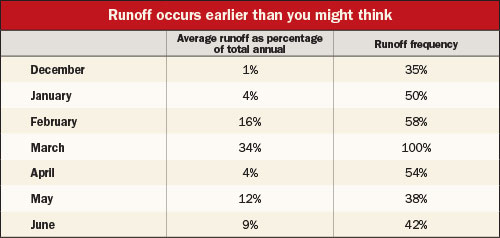
by Amanda Smith, Associate Editor
Field runoff volumes have a near equal distribution under frozen and nonfrozen ground conditions, said Kevan Klingberg with University of Wisconsin Discovery Farms at the Midwest Forage Association annual meeting.
Klingberg went on to add that there are two critical time periods when runoff is high: on frozen ground and early spring before the crop canopy.
Runoff from frozen ground begins occurring earlier than you may think. About half of the annual runoff farms will endure occurs during the months of February and March. In one location, manure was applied to frozen ground two weeks before the spring melt.
Applied fields (3,000 gallons of liquid manure per acre) gave up 2 to 2.5 pounds of phosphorous per acre. The majority of this was dissolved phosphorous which has serious algal growth implications downstream. Most phosphorous, though, will be lost during the nonfrozen ground period.
On the other hand, most nitrogen is lost during the frozen ground period. The majority of this loss is organic nitrogen, and losses averaged 7 pounds per acre per year.
Furthermore, when looking at manure applications from December to March, earlier applications contributed less nitrogen and phosphorous than those that occurred close to a snowmelt.
If you need to spread on frozen ground, a winter manure strategy is a must. You should also use caution in February and March and watch for manure management advisories in your area.








